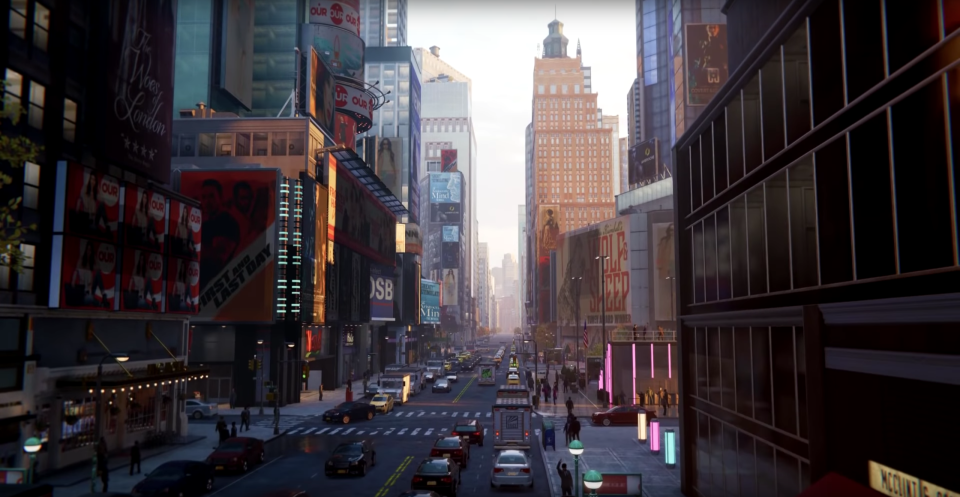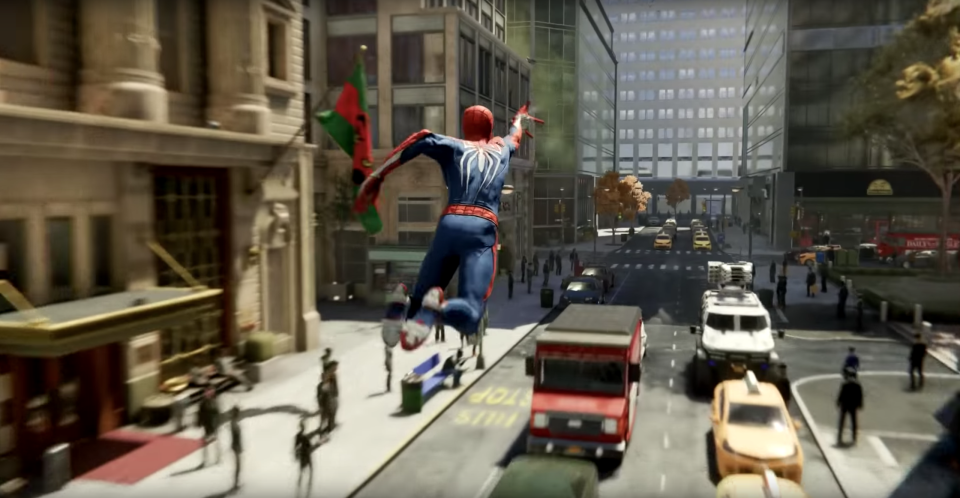How Marvel's Spider-Man Crafted a Perfect Digital New York City for You to Save
Here’s one thing I didn’t expect to feel when I turned on my Playstation 4 and started playing Marvel’s Spider-Man: nostalgia.
It’s been about a year since I moved from New York City to Los Angeles. But as soon as I picked up the controller and stepped into Spider-Man’s red-and-blue tights, I realized I didn’t need the in-game map. Anyone who has spent even a little time in New York City will be comfortable swinging around this digital recreation—navigating via web on streets that they learned, in real life, by walking or taking the subway.
In the hands of a player with the requisite New York baggage, playing Spider-Man can feel like forging your own intensely personal trail into the Uncanny Valley. In the middle of a mission, I couldn’t resist swinging away to crawl up the side of Spider-Man’s in-game equivalent of One World Trade Center—pausing for a snapshot when I found the block of windows that would line up with GQ’s actual offices. When I mentioned my little field trip to Jacinda Chew, the game’s artistic director, she didn’t sound surprised. "I hear a lot of people from New York are trying to look for their offices or apartments," she said, laughing.
When you’re swinging around Spider-Man’s Manhattan, it all feels so natural and effortless. That’s part of the game’s illusion, and what makes it such a joy to play. But early in development, the Spider-Man team had to confront a single, make-or-break question: How the hell do you recreate New York City in a video game?

It starts, I suspect, with accepting that you’ll never actually recreate New York City in a video game, for reasons that span from the practical to the legal. For what it’s worth, the One World Trade Center I know isn’t actually in the game—the victim of an apparent licensing problem. And if you explore Spider-Man’s Manhattan in detail, you’ll discover more than subtle architectural differences between the skyscrapers in the game and the skyscrapers in the real world. Marvel devotees will quickly track down a few Marvel-centric locations that, I am sorry to say, do not actually exist: Dr. Strange’s Sanctum Sanctorum, the detective office run by Jessica Jones, and the Avengers Tower looming over the city.
So no, Spider-Man does not recreate Manhattan. It creates a facsimile of Manhattan. And while it has countless differences, it feels, uncannily, like the real thing. "I’ve had New Yorkers tell me we totally captured New York," says Chew. "But it’s not a one-to-one representation of New York City. There are some liberal interpretations to it. That’s where the artistry comes in. I wanted to give the player the feeling of being in New York City. I always think of our 'New York City' as being the New York City of your imagination. And most of your imagination is a bit… fuzzy. Cabs are everywhere. The fire escapes. The water towers. I think of red brick buildings—which is funny, because in hindsight, I don’t think there are that many red brick buildings in New York City. We take those elements, and we crank it to 100."
This isn’t the first time a Spider-Man video game has done a remarkable impression of New York City. The Manhattan in the 2004 Playstation 2 video game Spider-Man 2—which, until last week, was the best Spider-Man game ever made—was broadly recognizable as New York City. If you knew the geography of Manhattan, you could orient yourself and go swinging through Times Square or stroll through Central Park. But on the whole, the sketch was pretty rough—a series of cookie-cutter skyscrapers assembled for Spider-Man to swing through, with your imagination doing most of the work.
Now, nearly 15 years later, the medium has evolved enough to make a fully-realized open-world city an actual possibility. It’s both an opportunity and a challenge, and every ambitious developer approaches it a little differently. It’s one thing for a video game like Batman: Arkham City, which was tasked with turning the fuzzy, mutable geography of the fictional Gotham City into a coherent, explorable place. But one of the great strengths of Spider-Man, as a character, is that he occupies and defends a real-life metropolis. Unlike Arkham City—a walled-off prison where your only random encounters are with criminals to fight—Spider-Man’s Manhattan is also supposed to be a bustling city, packed with pedestrians whose ordinary lives are occasionally interrupted by a jewelry-store robbery or a fist-bump from Spidey. If you’re going to be true to the spirit of Spider-Man, it’s the only option.
It’s also a huge hassle. "The first choice you have to make is whether or not to populate the city," says Chew. "Because if you do, it’s a big undertaking. That’s why a lot of games manufacture an excuse for the city not to be populated."

The earliest groundwork for the game’s version of Manhattan was done with Houdini, a program that could procedurally generate each of the city’s blocks, complete with walking pedestrians and driving vehicles. From there, it was up to the game’s artists to modify the generic gray boxes into a Manhattan that was both recognizable and fun to traverse via web. (If you’re not familiar with game design, picture it like this: Houdini’s job is taking a box of unpainted LEGO blocks and placing them in a series of neat, easily comprehensible rows. The artists are tasked with taking Houdini’s fundamental building blocks and modifying them—via height, color, or countless other factors—until they’re fun to play with.)
Spider-Man embraces the geography of Manhattan—and slyly goads the player into noticing all the hard work that went into crafting it—by encouraging you to take pictures of 50 landmarks around the city, with a second set of landmarks unlocking deeper as you get into the game. Most of them are real places any New York City tourist can visit. "We just put in as many real-life landmarks as we could," says Chew. "At some point, [the development team] runs out of time."
These real-life analogues put Spider-Man in the ever-growing tradition of video games that attempt to recreate the real world in a concrete, tangible way. 2003’s True Crime: Streets of L.A. boasted a 240-square mile recreation of Los Angeles, which was considered such a groundbreaking feature that developer Activision took journalists on a real-world trip that could be faithfully recreated in the game. Later games like The Getaway, Driver: San Francisco, and Sleeping Dogs applied the same treatment to cities across the globe. If developers weren’t careful, this could also lead to controversy—like when the Church of England condemned the Playstation 3’s Resistance: Fall of Man for setting a firefight in Manchester Cathedral.

In every case, the facsimiles remain imperfect. While it would be a massive task to model all five boroughs to Spider-Man’s level of detail, it’s a little jarring that the game simply turns you away if you try to head into Brooklyn or Queens—particularly when a police radio keeps buzzing about an incident at Brooklyn’s Atlantic Avenue. "We didn’t really discuss Brooklyn and Queens. We built out what was necessary for the story, and we didn’t need to go there for the story," says Chew.
But even with practical limitations, these digital cities come with a potential that I’m convinced remains untapped. I’m particularly fascinated by a game like L.A. Noire, which used on-the-ground research and aerial photographs to create a digital recreation of what Los Angeles looked like circa 1947. If you paid close attention, L.A. Noire could double as a history lesson, giving you an organic way to explore an approximation of what Los Angeles was like before the freeways irrevocably changed the city.
And there are early, intriguing signs that developers recognize that these digital landscapes might have value that stretches beyond the traditional video game experience. Four months after the game was released, the team behind Assassin’s Creed Origins debuted a free patch called Discovery Mode. The new setting allowed the player to explore the game’s well-researched approximation of ancient Egypt without missions or enemies. Instead, the game offered extensive narration describing the real-life historical analogues in this digital Egypt.
For anyone who knows New York as it is now, Spider-Man offers something a little different, though no less instructive: a chance to live out the fantasy of swinging around the streets of a Manhattan you’ve only seen from the ground. As I played Spider-Man, I was reminded of the very first teaser for Sam Raimi’s first Spider-Man movie, which ended with Spider-Man hanging a massive web between the two towers of the World Trade Center. That teaser debuted in the summer of 2001; after 9/11, it was pulled. But you can still find it online—a kind of unintentional tribute to New York City as it was before the World Trade Center fell.
And barring future updates to the game, Spider-Man’s Manhattan will eventually double as a time capsule of New York as it was—in a kind of funhouse-mirror fantasy version—in 2018. It’s an idealized, romantic version of the city: easy to traverse, abnormally friendly, and locked into a seemingly perpetual golden hour. Whether you’ve been to Manhattan or not, it’s the Manhattan of your dreams.
"It should feel familiar," says Chew. And it does—so much so that the player may feel a genuine sense of ownership over the New York City they’ve spent so much time protecting by the time Spider-Man’s credits roll. Of course, that was part of the plan all along, too, says Chew: “The city has to be a place that’s worth saving."

